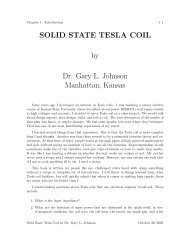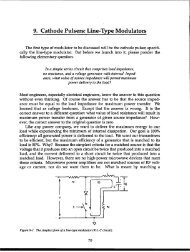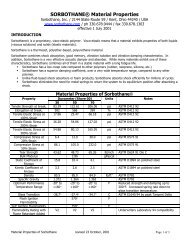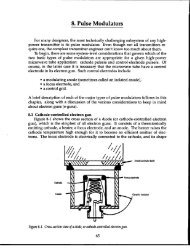3.6M north10.pdf - Dean-O's Toy Box
3.6M north10.pdf - Dean-O's Toy Box
3.6M north10.pdf - Dean-O's Toy Box
Create successful ePaper yourself
Turn your PDF publications into a flip-book with our unique Google optimized e-Paper software.
170 High-Power Microwave-Tube Transmitters<br />
The filaments of both tubes operate at 14.5 V and 450 A, or 6250 W. At the<br />
rate of 15 W per cathode peak ampere, the available cathode current should be<br />
435 A. The actual peak-cathode current rating is 550 A. Although the 8547 more<br />
efficiently converts cathode current to useful anode current, its peak-pulse output<br />
power under the conditions evaluated is 6 MW, whereas the peak power<br />
from the 7560 is almost 20 MW. Neither of these tubes employs any special<br />
strategy, either geometric or electromagnetic, to minimize grid current. The grid<br />
is no more sophisticated than a helix of wire wound around the array of cathode<br />
wires.<br />
10.4.2. The WL-8461 triode switch tube<br />
This is another example of a thoriated-tungsten cathode. The WL-8461 is a<br />
“big but simple” power-grid triode modulator switch tube. Many sockets throughout<br />
the world are also filled with this tube, but it is no longer being manufactured.<br />
It is, however, being successfully rebuilt.<br />
The WL-8461 is ‘%ig” in that its anode-voltage hold-off rating is 75 kV, its<br />
peak cathode-current rating is 750A, and its water-cooled anode-dissipation rating<br />
is 200 kW. It is “simple” in that nothing special was designed into this tube<br />
to minimize grid current. Figure 10-13 shows its anode- and grid-current characteristic<br />
curves. Using the same 90%-anode-efficiency criterion (which yields a<br />
conduction-anode drop of 7.5 kV) and a positive grid voltage of 3.5 kV, the anode<br />
and grid currents are 600 A and 92 A, respectively, for a total cathode current of<br />
692 A. The current ratio, therefore, is 6.5. Anode current is 8870 of cathode current<br />
and grid current 1270 of it. These values suggest a low p. (Its p is actually 25,<br />
which is somewhat low.) In Fig. 10-13a, note the cross-hatched area in the anode<br />
(plate) current characteristics just to the right of the virtual-cathode diode line.<br />
This cross-hatch area is bordered approximately by the +1500-V and +3000-V<br />
grid-voltage lines and the 3-kV and 7-kV anode-voltage lines. This is a region<br />
where a designer can expect oscillatory instability when the frequency is in the<br />
VHF range. The problem derives from the virtual cathode; there is a region of<br />
instability between the grid and anode where electrons don’t know whether to<br />
go forward or backward. (This same effect was deliberately exploited in the<br />
Vircator, or virtual-cathode oscillator, an ultra-high-power microwave device.)<br />
Another dimension of 8461 bigness is its directly heated cathode, which is<br />
Phvsicallv so large that it is divided into three sections and excited with 3-phase<br />
~c.” Each’section”operates at 15 V and 200 A, for a total of 9 kW input. At”15 W<br />
per ampere, the cathode current rating would be 600A. Figure<br />
external physical dimensions of the 8461 and the 7560 to give an<br />
size of tubes in this class.<br />
10-14 shows the<br />
idea of the large<br />
10.4.3 The ML- 6544 triode switch tube<br />
The objectives in placing the control grid close to the cathode are three-fold:<br />
s to maximize the perveance, or the current density, from the cathode as it<br />
relates to the 3/2-power of positive voltage applied between grid and<br />
cathode;<br />
“ to maximize the p-factor, which minimizes the negative voltage that must<br />
be applied between grid and cathode (or screen-grid and cathode in a







